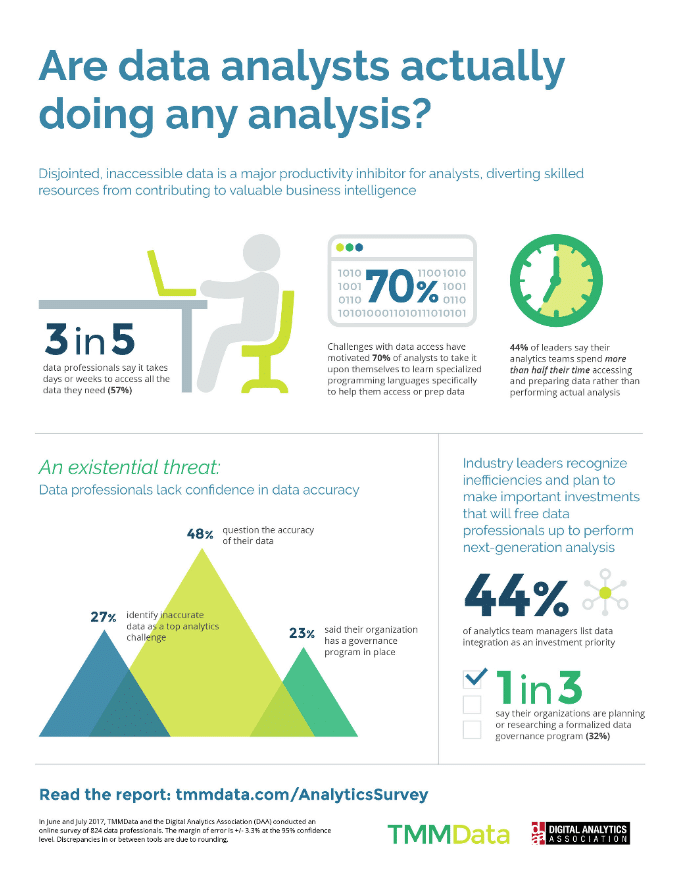Data overload is a fast-multiplying problem for brands and businesses striving to stay ahead of customer-retention trends by becoming more data driven.
But new research reveals that the problem isn’t just a matter of volume, it’s also a matter of disorganization.
A new study from data integration firm TMMData preparation platform Foundation and the Digital Analytics Association (DAA) shows that data access, quality and integration present persistent, interrelated roadblocks to efficient and confident analysis across industries—revealing that nearly 40 percent of data professionals spend more than 20 hours per week accessing, blending and preparing data, rather than performing actual analysis.
Key findings of the research:
Disjointed, inaccessible data is a major productivity inhibitor for analysts, diverting skilled resources from contributing to valuable business intelligence
Nearly two in five (38.7 percent) data professionals are spending more than half of their work week on tasks unrelated to actual analysis: 43.8 percent of managers reported that 51 percent or more of their team’s work week is spent collecting, integrating and preparing data rather than analyzing it, while 31.3 percent of analysts said they spend 21 or more hours a week on data housekeeping.
Many data professionals struggle with data access
Forty-three percent of respondents named access as one of their top two analytics challenges. Nearly three in five respondents (56.9 percent) said it takes days or weeks to access all the data they need, and nearly one in 10 (9.8 percent) say they can rarely or never access a complete range of data sources. Only a third of data professionals (33.4 percent) are immediately able to access all their data, or can get it in less than a day.
As a result, a majority of analysts find it necessary to learn programming languages specifically to help them access or prepare data for analysis. Outside of mandates from their employers, a full 70 percent of analysts reported taking it upon themselves to learn to code for this reason, and more than a quarter of those analysts have spent 80 or more hours learning to program.
Data professionals lack confidence in data accuracy, which poses an existential threat to the industry
The industry is split in terms of confidence in data accuracy, with a little more than half saying they are always or reasonably confident in the data their teams work with regularly (51.7 percent), and slightly less than half reporting that they question the accuracy of that data (48.3 percent). In fact, second only to data access, 26.7 percent of respondents identified inaccurate data as one of their top two analytics challenges. Data professionals tasked with analyzing organizational information meaningfully and actionably can’t adequately perform their core job function without accurate data, incenting the industry to invest in data quality.
A lack of formalized data governance programs could be to blame for some of the uncertainty surrounding data quality; less than a quarter of respondents said their organization has a governance program in place (22.7 percent). Nearly one in five (18.2 percent) reported that each department is responsible for its own data governance, rather than having a comprehensive organizational governance program ensuring consistency across business units.
The industry recognizes its areas of inefficiency and is poised to make important investments that will free data professionals up to perform next-generation analysis
The survey findings indicate a consensus among industry professionals on the importance of solving data access, integration and governance problems. In addition to the statistics already discussed, data integration was the most frequently cited investment priority for the upcoming year (as reported by more than 40 percent of management and 37.8 percent of staff). Nearly a third (32 percent) of respondents’ organizations are planning or researching a formalized data governance program, and nearly two in 10 (19.4 percent) are in the early stages of rolling out their governance programs, primarily with the goal of ensuring that everyone is working with consistent data.
“Making analytics professionals more effective and valuable is at the core of the DAA’s mission, so it’s important for us to track the issues that create barriers in their daily work,” said Marilee Yorchak, DAA executive director, in a news release. “By collecting and sharing our findings on the impact of siloed, disjointed data with our members and the analytics industry at large, we believe we’re both validating and elevating concerns that data professionals have had for years, and are more prepared than ever to tackle.”
“In the decade that we’ve been providing data integration software to the industry, the roadblocks to efficient analysis have worn down to a small degree—but even as more nimble and sophisticated BI tools and analysis platforms evolve, clients are still coming to us with basic data access and preparation challenges,” said Bob Selfridge, TMMData CEO and founder. “The industry as a whole still seems to be struggling to give analysts the quality data, quick access and self-service tools that will make it possible for them to focus on analysis rather than housekeeping.”
TMMData partnered with the DAA to survey its community members via an email invitation to an online questionnaire, fielded between June 8 and July 14, 2017. More than 824 qualified responses were collected and analyzed to produce this press release and infographic with a 3.3% margin of error at the 95% confidence level.




